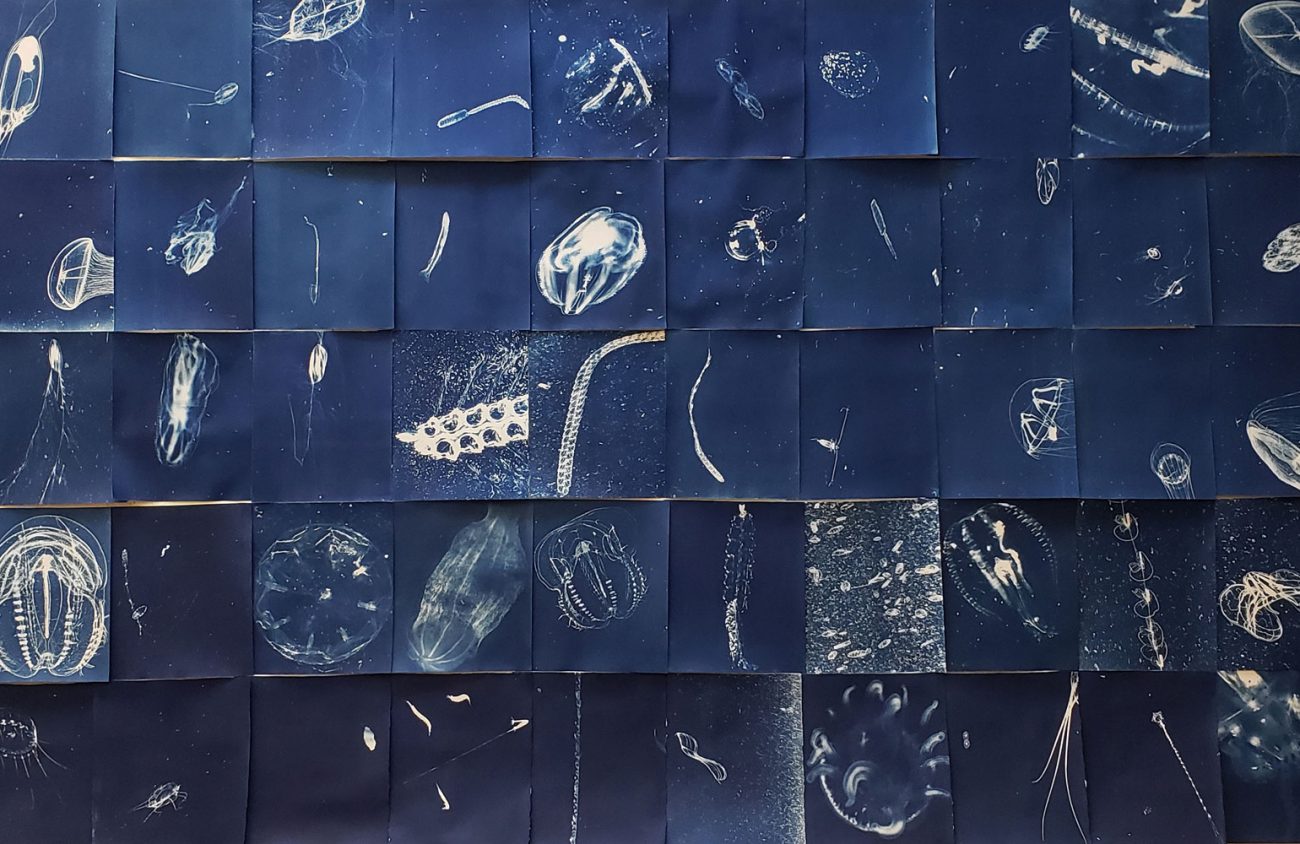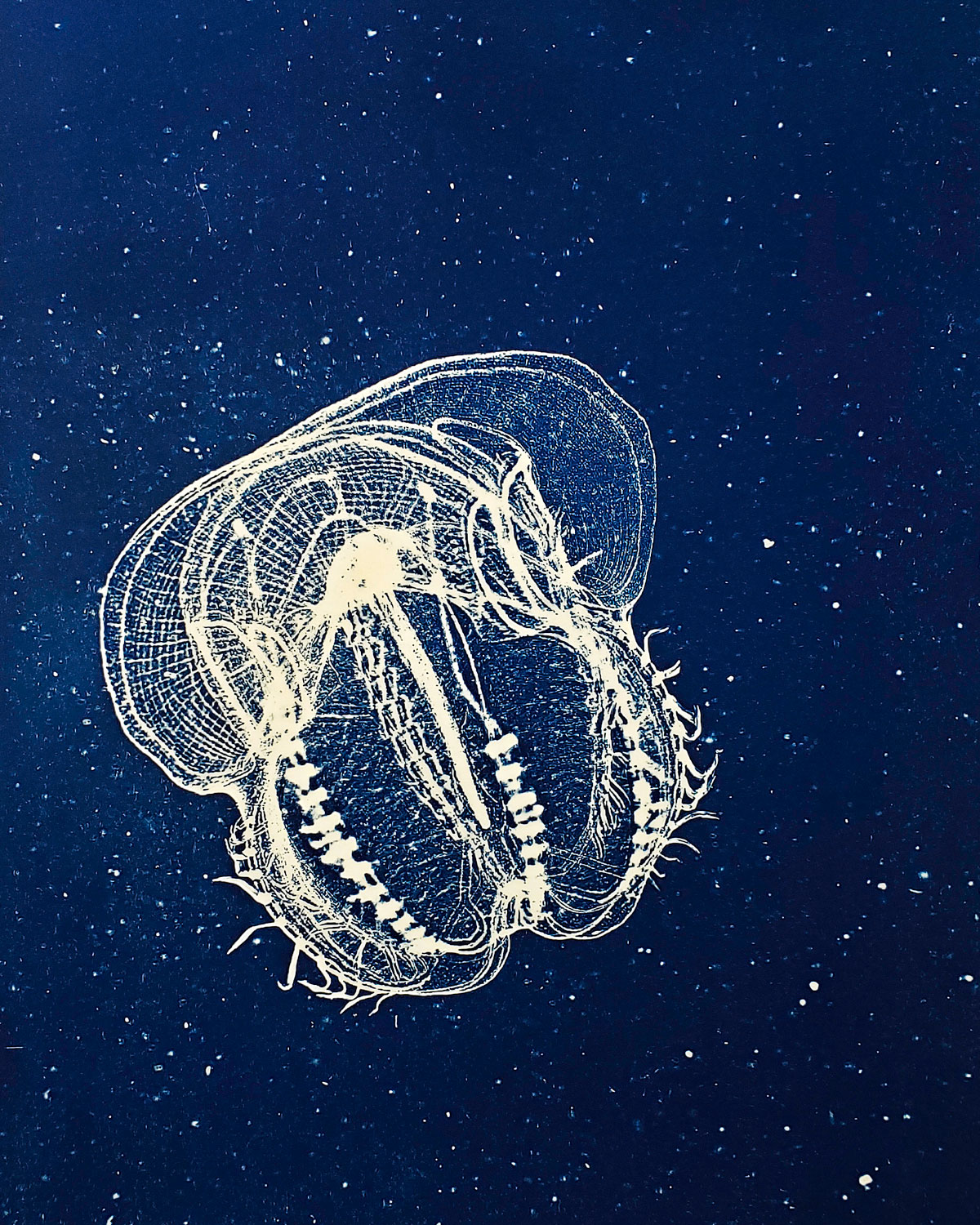Eugene artist and photographer Sarah Grew recently spent two weeks aboard a research vessel off the Oregon coast creating cyanotypes of plankton. The unusual science/art collaboration came about through a residency with the Sitka Center For Art and Ecology in Otis.
Eugene Weekly recently asked Grew about her experience. The interview has been edited for length and clarity.
How did you first get interested in photography?
My interest in photography started as a small child with a contact printing frame, some old negatives, a box of expired photo paper and an older brother who knew more than I did. From there, I graduated to a Brownie camera and a darkroom in the basement and then took photo classes in high school.
How did you make the transition to cyanotypes?
I first became interested in cyanotypes a few years ago when I started really focusing on temporality and time in my work. I wanted to create art that layered the most important visual art technologies humans have come up with to create cycles of time. By visual technology, I mean the material and technique we use to express ourselves visually. The most important ones have revolutionized the way we see. Photography is the most recent of these. The others, going back in time are; Printmaking, oil paint, tempera, encaustic, ink and charcoal — the first means of drawing.
The cyanotype is a very simple but stable process. It was invented in 1842, only three years after photography was patented. It does not require a darkroom, only a dim room, using sunlight or UV for exposure. It is an iron-based printing-out process that mixes ferric ammonium citrate and potassium ferric cyanide, and it can be done on any porous surface. Traditionally the cyanotype is used for photograms, where you place an object on the sensitized paper.
The way I do my prints is to create a digital negative. The hard part of cyanotypes and many of the processes where you can’t use an enlarger to size your image is creating a digital negative that will produce a well-balanced image in terms of tonal range.
Can you briefly describe the residency program?
The residency selection process was overseen by the Sitka Center in conjunction with science teams from Oregon State University and the University of Oregon. Once I was selected as a finalist, I did a Skype interview with the science team. One of the principal investigators for the project is Kelly Sutherland, who teaches here at UO.
What was it like to live on a boat for two weeks?
Pretty magical, both in its beauty and in its demands. The ability to be completely away from everything was fantastic: no errands, no phone, no cars, just enough internet to send emails, none of the usual distractions, no cooking but lots of eating.
There’s beauty in being able to see 360 degrees to an open horizon in all directions. Watching the sun rise and fall, the stars in the sky, the dolphins dancing in the water on calm mornings, the colors of reflections, the rolling of fog, the shore coming into view, being rocked to sleep at night. Those moments sitting on the deck with the sun in my face just enjoying being there.
On the other hand, on a boat there is not much privacy, and most spaces are confined. Stairways are narrow and steep. Staterooms are for two people. I was surprised to find I couldn’t even sit up all the way in my bunk without hitting my head on the one above it. You can’t idly set things down, as they could slide, spill or fall with a big wave.
There is constant motion, constant sounds of the engines, and lots of smells. I admit that diesel fumes are not among my favorite aromas, and if one is feeling a bit seasick those smells are amplified.
How did you make photos on the boat, and what were you photographing?
One of the data collection methods the scientists were using is a photo capturing system called ISIIS, which stands for In-Situ Ichthyoplankton Imaging System [see PlanktonImaging.com]. Essentially, the system takes photos of plankton that pass in front of the camera at 90 frames a second as they float through the water.
We were dragging the camera behind the boat, raising and lowering it in the water, all day on alternate days. I would then look through the images and choose ones I thought were interesting. I also used a camera on a microscope to capture additional images of specimens we brought up. By the end of the trip the scientists had 32 terabytes of data from ISIIS.
What was the process of converting those photos to cyanotype?
After I selected an image, I converted to black and white, made adjustments and inverted. I brought a portable photo printer with me on the boat, and I used that to print film negatives. I used an empty stateroom to sensitize my paper. I squeezed the negative against the paper and exposed it to sunlight on the deck. Depending on the time of day and the quality of the light, exposures were four to 20 minutes. One of the great things about the cyanotype process is that it uses plain water to develop the image, which there is plenty of. Actually, many of the ones I made on the boat I developed in sea water.
What drew you to plankton as a subject?
In 1839, the first photographic process was patented. In 1842, the cyanotype photographic process was invented. One year later, Anna Atkins, called the first woman photographer, printed the first book that contained actual photographs, Photographs of British Algae. Her images were cyanotype photograms of sea algae. The volumes still exist today without having faded. My project Photographs of Plankton was to create a companion volume to Anna Atkins’ book. Plankton has environmental importance to the food web and life of the ocean and, therefore, our planet.
What was the most surprising thing about the experience?
In terms of work, the most surprising thing was how similar doing scientific research is to making art. The science team is a team, so in that way it is different. But they are taking the materials of their research and trying to find answers to difficult questions through probing those materials.
That is just what I do. I think the other surprising thing was how hard everyone has to work. It is a small city in a sense, and there is constant attention needed by the science teams and the crew.
What are your plans for the photographs?
On the boat I only printed test images, so right now I am printing the final images. The science team had four cruises, and an artist on each. I was the only artist working in photography. There are plans to have group exhibitions at each of the universities involved and at Sitka. I am proposing a standard print version of the book to several publishers and hope to have it printed that way as well as having the limited edition hand printed version and single prints.
The exhibition Marine Food Webs: Drifters to Swimmers will be at the Giustina Gallery at Oregon State University from Feb. 3 through March 12. An opening reception will be 5 to 7:30 pm Thursday, Feb. 6. The exhibition will include work by all four of the Artists-at-Sea who participated in the residency program.

